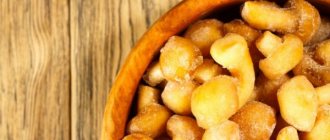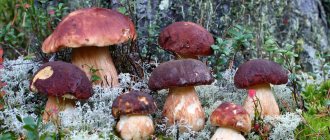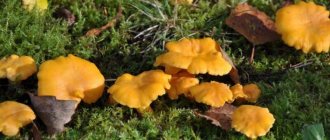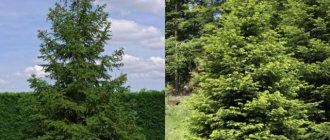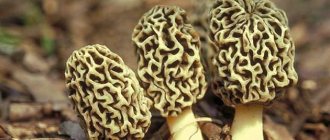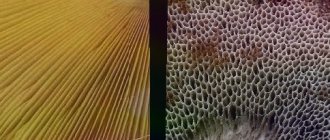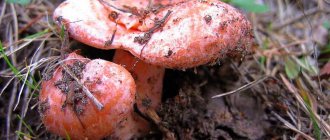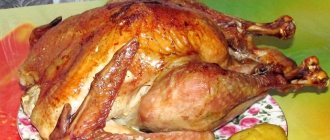Many people love to collect yellow mushroom. The so-called mushroom hunting is a year-round concept that has variable intensity in different periods.
Mushroom picking is not only a hunt for a mushroom harvest, but also an entertaining walk through the forest. Everyone knows that you can only collect edible species that can be eaten without risk to health. Edible and inedible ones differ in shape, color and structure. In order not to get into trouble, you should carefully study all types of edible plants.
Yellow mushrooms are especially popular among mushroom pickers due to their beautiful appearance and unusually pleasant aroma. These representatives have a lot of useful properties. They grow in different latitudes. Yellow species are used in cooking and medicine. When going for mushrooms, you should carefully study how they look based on the description and photo.
Instead of meat
Today it has become fashionable to eat only plant foods. But sometimes you really want to eat a dish that smells like fried chicken. An unusual yellow mushroom comes to the rescue; its name is sulfur-yellow tinder fungus. Dishes prepared from it have the smell of chicken meat.
Sulfur-yellow tinder fungus grows on a tree. In the photo of young plants you can see a bright yellow color, thanks to which the plant can be seen several tens of meters away. This species is found in different latitudes. Situated on trees in small groups. Only young varieties can be eaten, because as the tinder fungus grows and accumulates toxins, it becomes poisonous.
Before cooking, the tinder fungus should be boiled for 30 minutes. Can be used in soups, roasts, casseroles, can be pickled and dried. Polypore is very often used for medicinal purposes. It contains 70% of useful substances that contribute to the normal functioning of the human body. Medicines are made from tinder fungus and are prescribed for the treatment of the liver, bile ducts and respiratory system. In pharmaceuticals you can find laxatives based on this plant.
Such common saffron milk caps
Camelina is another variety of orange mushroom. They are distinguished by their bright orange, even red color. They are highly valued for their taste; some subspecies are even considered a delicacy. Saffron milk caps owe their color to a substance such as beta-carotene, which is converted into beneficial microelements (B vitamins, ascorbic acid, vitamin A).
This family is also rich in mineral salts of iron, magnesium, phosphorus, sodium and even calcium. Moreover, these mushrooms contain a natural antibiotic - lactrioviolin, which is used for inflammatory diseases and is used in complex therapy in the treatment of tuberculosis. Let's talk about some types of these edible orange mushrooms.
Types and varieties
Yellow mushrooms come in a variety of varieties and differ from each other not only in appearance, but also in name. You can see all the main external differences in the photo.
There are several types:
- One interesting species is popular, called Yellow Hedgehog. Among avid mushroom pickers, this species is also called Gidnum notched. Famous for its pleasant fruity aroma. If you carefully study the photo of the yellow hedgehog, you can see that its cap is quite dense, with pulp. The surface of the cap is yellowish, lumpy and irregular in shape. During periods of drought, the surface of the cap tends to fade. The hedgehog is characterized by a leg, the diameter of which can reach 4 cm. The leg is white, dense, cylindrical in shape, sometimes slightly curved. The mushroom grows in coniferous or deciduous forests. Blackberries bear fruit at the end of summer and beginning of autumn. These mushrooms most often grow alone, but are sometimes found in small groups. During heat treatment, the product does not change its size, which is why housewives love it. The plants have a sour taste, which is very similar to chanterelles. You can cook it in any way. Famous chefs recommend frying with onions and sour cream. In folk medicine, hedgehogs are used to boost immunity and renew blood. Various ointments are made from these plants to treat skin diseases. In the field of cosmetology, they are used to make regenerating face masks.
- Another 1 species is the yellow cobweb. These species have large, bright yellow caps. The hat can reach 12 cm in diameter and has a smooth and adhesive surface. Sometimes the cap becomes covered with a white coating. The pulp has brown plates. Cobwebs have a stem ranging from 7 to 14 cm in height, and it is quite thick in diameter. Most often, spider webs can be found on calcareous clay soil. Thanks to its bright yellow cap, this representative is visible from afar, which makes the search much easier. The taste of the cobweb is soft and delicate. Some cooks prefer pickling.
In the photos of real representatives you can see that they all have some similarities. This is a thick stem, a cap with a bright yellow color. They have a soft and delicate taste.
Edible tube mushrooms
The most popular:
- White mushroom or boletus . You can find it in spruce forests, pine forests, and mixed forests. In young mushrooms the cap is strongly convex, in old ones it is almost flat and colored brown. Its lower part consists of a tubular layer, which can change color from white to yellowish-greenish. The stem is brown in color, reaches 10–15 cm in length and 7–8 cm in width, is white inside, has a pleasant aroma and taste. Mushrooms grow quickly. Large specimens are found. A well-known record is a six-kilogram boletus.
- Butter. Their cap is covered with mucus. It has a conical shape and brownish-brown color. In young people, the lower part of the cap is covered with skin; with age, it tears, and a ring remains on the stem. You can find boletus in the pine forest. Collection time June – September. They are marinated, fried, boiled.
- Mosswort. Painted yellow-brown. Grows in a pine forest. Collection period July – October. With age, the hat changes shape from convex to flat. It is about 5 cm in diameter. The inside of the mushroom is yellowish, after a while it turns blue.
- Boletus . The hat is red. Grows up to 20 cm in diameter. The height of the mushroom is 18 – 20 cm. Weight is up to 2 kg. Found under aspen, pine and birch trees. The pulp is white.
- Polish mushroom . Rarely seen. Similar in appearance to boletus. The hat is roundish and dark brown. Grows in old pine forests. It has an original taste.
- Boletus . Grows in birch forests. Looks like a boletus. It has scales painted black. The cap is strongly convex, covered with skin underneath, which is difficult to separate from the pulp. It is painted gray. The mushroom quickly deteriorates and worms grow in it. Therefore, young mushrooms are collected for pickling, pickling, frying, and boiling. Seasonings are often prepared from it.
Basic collection rules
You should know the description of the mushroom very well so as not to harm your own health. But, having studied the entire mushroom encyclopedia, you should not forget about the basic rules of collection and processing. Representatives of bright yellow color are detected quite quickly, but it is still worth walking carefully through the forest in order not to damage undetected mushroom groups.
To collect, you should take with you a small but sharp enough knife and a low basket. Once plants are found, they should not be uprooted. The leg is cut from below at the base. To prevent damage to the crop, the cap should be facing down and the stem facing up in the basket.
Experienced mushroom pickers have created the following rules that should be strictly followed:
- You can’t taste a plant in the forest;
- You should not collect species of dubious appearance;
- do not cut off old plants;
- do not mix different types of crops in the basket;
- it is advisable to go on a quiet hunt with experienced people;
- if the leg is too thick at the bottom, there is no need to take such a specimen;
- Before going to the forest, you should refresh your knowledge about different types of plants.
First of all, you should know exactly what inedible species look like. Poisonous ones are recognized by certain characteristics. The very first one is color. Poisonous specimens have an unusual color, most often it is unnaturally bright, red-yellow. Also, poisonous varieties do not have worms or other insects that like to feast on mushroom pulp. The last sign that distinguishes good varieties from poisonous ones is smell.
Most often, poisonous ones have an unpleasant odor, with a hint of chlorine and rot.
Spruce mushroom
This is a mushroom with an orange cap from the Russula family. Its cylindrical leg (three to seven centimeters high and one centimeter thick) is quite brittle and hollow inside. The orange pulp, turning green when broken, has a fruity aroma and taste. The small orange cap of the plant has a diameter of four to eight centimeters. The plates, descending and frequent, are slightly lighter than the cap itself. The color of the mushroom itself can vary between pale pink and dark orange. Spruce saffron milk caps grow from summer to autumn in spruce forests, hiding in the natural litter covered with pine needles.
Red saffron milk caps
This is another variety of lamellar mushrooms. The cap is orange in color, dense and fleshy to the touch, and varies in diameter from five to fifteen centimeters. The flesh of the mushroom is white, with dark red spots randomly located on it. When broken, the pulp releases thick, blood-red juice. Frequent and thin plates, located under the bottom of the cap, descend deeply along the stem of the camelina. The leg itself is small, about four to six centimeters high, tapering towards the bottom. It is covered with plaque and furrowed with red pits. The color of the leg can be different: orange, pink and even purple. This type of mushroom is not widespread in Russia; it most often grows in coniferous forests on mountainous slopes.
Chanterelles
Chanterelles are a whole family of mushrooms with an orange stem and the same cap. Not all of them are edible, as it might seem at first glance. The following names of mushrooms are considered tasty and nutritious: velvety chanterelle, faceted chanterelle and yellow hedgehog.
The cap of the velvety fox is small, about four to five centimeters. The leg is also small, measuring two to three centimeters. The orange pulp is tender and slightly sour in taste. The fungus settles in acidic soil, mainly among deciduous plants.
The faceted chanterelle is a very beautiful representative of wildlife, with a fibrous fruiting body ranging in size from three to ten centimeters. Forms mycorrhiza with oak and grows from June to October. Poisonous chanterelles include species such as the false chanterelle and olive omphalot, which is found quite rarely, mainly in the Crimea.
Poisonous
False chanterelle is an inedible orange mushroom that resembles a chanterelle. Its other name is orange talker. The talker differs from its edible counterparts in the red-orange hue of the cap and almost smooth edges, as well as an unpleasant odor. The mushroom cap varies between two and six centimeters in diameter, and the stalk, usually very short, rarely reaches four centimeters. And yet, false chanterelle is considered a conditionally inedible product, as it is successfully used in the cooking of other countries after long and thorough heat treatment.
Orange-red cobweb is another type of poisonous mushroom that is considered deadly. The hemispherical cap of the spider web has a small tubercle in the very center, and the leg, small in height, tapers towards the base.
So, we briefly looked at the description of different mushrooms with orange colors. Now let's briefly discuss how to distinguish an edible mushroom from an inedible one.

